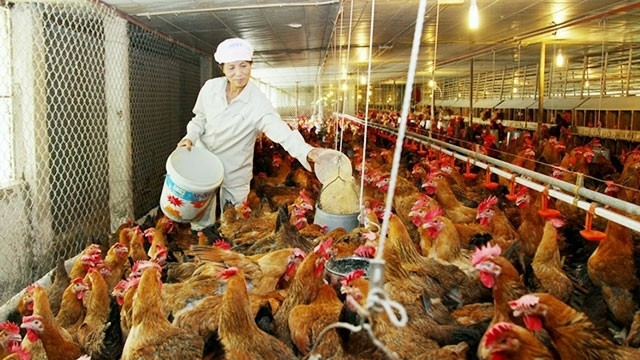According to Acting Director of the Department of Livestock Production Duong Tat Thang, the first challenge for livestock farming is the unpredictable developments of diseases in livestock. African swine fever, foot-and-mouth disease, and lumpy skin disease on buffaloes and cows are still appearing in many localities. Some provinces and cities have even detected strains of avian influenza virus A/H5N8.
In Hanoi, avian influenza A/H5N8 was found in two farming households in Ba Vi District, resulting in the elimination of more than 2,500 chickens. These outbreaks have lasted less than 21 days and are being closely monitored.
The livestock farming is also facing impacts of climate change including prolonged heat and heavy rains, creating prime conditions for the outbreak of diseases.
In addition, the COVID-19 pandemic is progressing complicatedly, causing disruption to global supply chains and congestion to the distribution and circulation of goods, thus directly affecting the production and export of livestock products. Some products have failed to meet the set export targets, such as silk, honey, and bird's nests.
Our country's deep integration in the world through new-generation free trade agreements with the participation of partners with advanced livestock production will increase market pressure for Vietnamese livestock products.
The problem of environmental pollution and the continuous increase in the prices of raw materials and animal feed since November 2020 has also led to increases in production costs and reductions in the competitiveness of some livestock products.
If Vietnam cannot quickly develop its own raw materials and animal feed instead of importing them from other countries, it will be difficult for the domestic livestock farming to develop sustainably.
In addition, the livestock and poultry slaughtering system still reveals inadequacies in addition to shortcomings in food safety and hygiene. The State management agencies are still confused and passive in dealing with issues including biosafety breeding models suitable for each type of animal, the control of breed quality and breeding conditions, livestock industry management database, and others.
According to experts, to make the livestock industry adapt to a new stage of development, localities need to actively implement the Law on Livestock, the Strategy for livestock development towards modernisation, the industrialisation of large-scale farming, and the professionalisation of household farming.
It is also necessary to clearly define the characteristics and competitive advantages of each region in order to concentrate resources for production and increase the added value of livestock products.
The livestock product consumption system for the domestic market should be strengthened in the direction of forming linkage chains between production, processing, circulation and consumption.
Ministries, sectors, provinces and cities need to continue strictly implementing epidemic prevention and control measures under the direction of the Government and the Ministry of Agriculture and Rural Development in order to avoid the recurrence and spread of diseases among animals.
In parallel with epidemic prevention and control, localities should implement policies on loan interest rates and land to support livestock farmers to maintain production. It is advisable to encourage investment in livestock farming according to value chains while building large-scale livestock complexes with the application of technical advances.
It is significant to strengthen the capacity of breeding production establishments to have low-cost and disease-free breeds.
Authorised agencies must strictly handle the illegal import and export of breeding animals and livestock products and regularly inspect distribution channels and slaughtering of livestock products while reducing the dependence on imported raw materials and animal feed.
Deputy Minister of Agriculture and Rural Development Phung Duc Tien said that the livestock industry needs to continue to reform administrative procedures and cut business requirements to create more favourable conditions for people and businesses to invest in the livestock sector, especially the processing stage, to increase the value of livestock products.
















